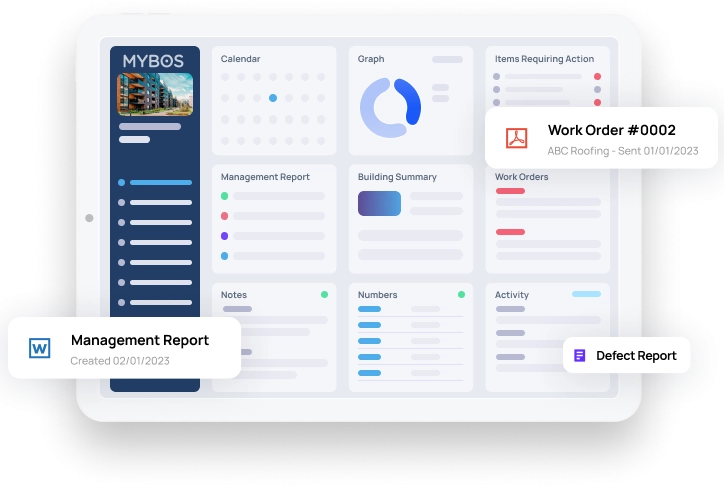
8 Essential Compliance Tasks Every Building Manager Should Prioritise
Compliance isn’t just a box-ticking exercise—it’s your first line of defence against safety risks, operational downtime, and costly legal issues. For building managers, ignoring key compliance responsibilities can quickly lead to fines, liability concerns, or reputational damage.
To stay compliant, you need more than good intentions—you need a clear understanding of what’s required and how to manage it consistently. Rising regulatory expectations in commercial real estate, not only in safety and sustainability, but across financial disclosures and tenant protections, are increasing compliance costs and operational complexity. Updated frameworks now demand stronger controls, more frequent reporting, and greater accountability from property managers and owners.
In this article, we outline the top eight compliance tasks for building managers plus tips on how to stay ahead using smart building management tools.
1. Fire Safety Compliance
Fire safety remains one of the most important and heavily regulated areas in building management responsibilities. Building managers must ensure:
- All fire extinguishers and fire hose reels are functional, serviced and accessible
- Schedule and document regular fire alarm and sprinkler system tests
- Annual Fire Safety Statements (AFSS) are submitted on time
- Evacuation plans are visible and up to date – maintain clear evacuation routes and update fire safety plans
- Conduct mandatory fire drills with building occupants
Non-compliance here can result in significant fines and severe risk to tenant safety. Consider using building compliance software to automate inspections and track compliance dates.
Read more on Why Regular Building Inspections Are Critical for Property Managers
2. Routine Building Inspections
Routine building inspections are key to detecting wear and tear, assessing risk, and preventing costly repairs. Inspections should cover:
- Inspect common areas, electrical, roof, guttering, lighting, and entry points for hazards
- Log and rectify any safety, structural or maintenance issues
- Ensure compliance with state and federal building codes and standards
- Keep inspection reports up to date for auditing purposes
Using a digital compliance management platform ensures these checks are documented and actioned efficiently, creating an audit-ready trail.
3. HVAC System Compliance
A poorly maintained HVAC system isn’t just inefficient, it can be a health risk. Building managers should regularly:
- Inspect and clean HVAC air filters and ducts
- Schedule regular servicing and filter replacements
- Check for compliance with indoor air quality and energy standards
- Maintain records of inspections, repairs, and refrigerant usage
- Ensure systems meet manufacturer and regulatory maintenance schedules to avoid breakdowns
HVAC performance also impacts a building’s energy rating, making it a key task in your building compliance checklist.
Facilities Management Journal also highlights the value of centralised digital records and predictive maintenance tools as effective solutions for keeping HVAC systems safe, compliant, and reliable over the long term.
4. Lift Maintenance Requirements
Lift maintenance requirements in Australia are governed by strict engineering and safety regulations. Regular tasks include:
- Monthly mechanical inspections
- Annual full-service checks by a certified contractor
- Emergency communication system testing
- Compliance logbook updates
Failing to meet these requirements can result in operational shutdowns, legal consequences, and serious safety incidents.
SafeWork NSW mandates that those managing lifts, escalators, and moving walkways ensure regular inspection and upkeep. Facilities must remain operationally safe and compliant with standards like AS 1735, while keeping documented maintenance records and certifications readily available
5. Emergency Procedures for Buildings
From natural disasters to health emergencies, all buildings should have clear emergency procedures in place. These include:
- Designated assembly points
- Emergency contact signage
- First aid kit availability and maintenance
- Staff training for lockdown, evacuation, or shelter-in-place protocols
Digitising your emergency procedures through a building management platform ensures rapid updates, streamlined staff coordination, and improved communication with tenants during critical situations.
FMA’s Facility Management Good Practice Guide emphasises the importance of emergency planning in multi-unit residential environments. It strongly endorses scenario-based training, clearly defined evacuation records, and continuous improvement practices, all of which improve safety outcomes and ensure readiness for audits or compliance reviews.
6. Strata Compliance Obligations
If you’re managing strata-titled buildings, your strata compliance obligations extend beyond standard maintenance. Tasks include:
- Managing owner corporation meetings and reporting
- Coordinating with strata committees on repair approvals
- Ensuring by-laws are enforced and reviewed regularly
- Handling disputes and compliance breaches
Staying on top of these responsibilities is essential for maintaining legal compliance, resident satisfaction, and overall building harmony.
For a deeper understanding, compare the broader scope of Building Asset Management vs Asset Tracking.
7. Contractor Compliance Tracking
Whether it’s pest control or plumbing, every contractor working onsite must meet compliance standards. This includes:
- Valid insurances and licenses
- Safety inductions completed
- Up-to-date ABNs and background checks
- Sign-in and work log documentation
Consistent contractor compliance tracking not only reduces liability but also promotes a safer, more transparent working environment.
CREtech highlights how modern vendor management platforms tools] helps in property managers eliminate risks and streamline contractor oversight. This makes compliance tracking far more efficient than manual systems.
8. Building Code Compliance Updates
Finally, staying across updates to the National Construction Code (NCC) and other building code compliance standards is a must. Recent updates have included:
- Enhanced accessibility requirements
- Updated thermal performance standards
- New combustible cladding regulations
Tracking these changes manually is time-consuming. A digital solution can automatically notify you of relevant changes and help apply them across your sites.
Sourceable reports that the Australian Building Codes Board’s NCC 2022 introduced major changes with NCC 2025 set to tighten thermal, energy, and accessibility rules. Staying updated is key to ensuring compliance and protecting asset value.
Best Practice: Using Smart Tools to Streamline Your Building Compliance
Compliance isn’t just about ticking boxes, it’s about safeguarding people, property, and reputation. By prioritising these eight core tasks, building managers can stay ahead of legal obligations, build tenant trust, and create safer, more efficient properties.
Modern property managers are moving away from spreadsheets and siloed systems; and with rising regulatory pressure and shrinking time margins, having a reliable digital platform isn’t just nice to have, it’s essential. If you’re currently evaluating your tech options, here are 3 Key Tips for Choosing the Right Building Management Solution.
Ready to see how MYBOS can simplify your compliance workflow? Book a free demo today and discover how our platform supports full-spectrum facility compliance management, asset tracking, inspections, and more all in one place.





